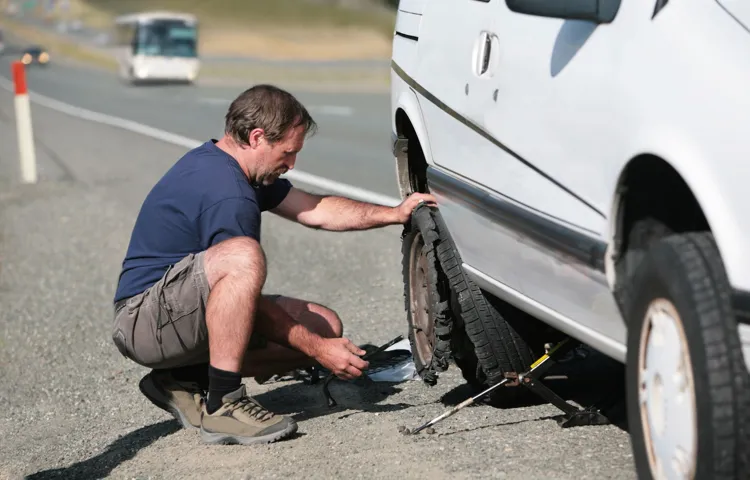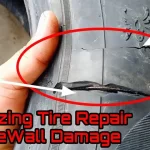Picture this: You’re driving down the highway, enjoying the scenery and the music blaring from your speakers, when suddenly your tire blows out. The sound is deafening and your car starts to veer off course. What do you do? A tire blowout can be a terrifying experience, but it’s important to stay calm and know what steps to take to keep yourself safe.
In this blog post, we’ll discuss what causes tire blowouts, how to prevent them, and most importantly, what to do if you find yourself in this situation while driving on the highway. So sit tight and let’s get started!
Table of Contents
Introduction
If you have a tire blowout when driving on the highway, you should not use your brakes until you have successfully regained control of your vehicle. This may seem counterintuitive, but braking while the tire is blown out can cause your car to spin out of control, leading to potentially deadly accidents. Instead, you should focus on steering your car to a safe location off the road without making any sudden movements or overcorrecting.
Once you have successfully navigated your vehicle off the highway, you can then begin to gently apply your brakes to bring your car to a gradual stop. Remember, the most important thing when experiencing a tire blowout is to remain calm and in control of your vehicle, while being aware of your surroundings. By following these guidelines, you can minimize the risk and damage caused by a tire blowout, and keep yourself and other drivers safe on the road.
The Danger of Braking After a Blowout
The danger of braking after a blowout is a topic that often goes overlooked, but it is one that could save lives. When a tire blows out, the sudden loss of air pressure can cause your car to swerve, making it easy to panic and slam on the brakes. However, this can actually make the situation worse.
When you brake after a blowout, you shift the weight of your car forward, making it more difficult to steer, especially if you’re already losing control of the car. Instead, it’s recommended that you try to maintain control and steer your car in a straight line until it slows down naturally. Once you’ve slowed down, gently apply the brakes to bring your car to a complete stop.
By keeping a level head and following these guidelines, you can avoid making a dangerous situation even worse.

Statistics on Tire Blowouts
Tire blowouts can be caused by a multitude of factors, ranging from overloading your vehicle to poor tire maintenance. According to recent statistics, tire blowouts are a serious issue on American roads, causing over 11,000 accidents annually. In addition to that, tire-related crashes result in around 200 fatalities and 6,000 injuries each year.
The majority of these accidents occur during hot weather months, when poorly maintained tires are more prone to burst. Maintaining your tires by checking the air pressure and tread depth regularly, as well as having them inspected by a professional on a regular basis, can help reduce the risk of experiencing a tire blowout while driving. Remember, taking proper care of your tires not only ensures your safety but also the safety of others on the road.
What to Do When You Have a Blowout
If you have a tire blowout when driving on the highway, the most important thing to remember is not to use your brakes right away. This might seem counterintuitive, but slamming on the brakes can cause your vehicle to swerve or fishtail, increasing the risk of losing control and potentially causing an accident. Instead, try to stay calm and keep a firm grip on the steering wheel as you gradually ease off the accelerator.
As you slow down, you can begin to gently apply your brakes, but make sure to do so slowly and cautiously. Once you’ve safely come to a stop, assess the damage to your tire and call for assistance if needed. Remember to always stay aware of your surroundings and other drivers on the road, and never put yourself or others in danger by reacting impulsively to sudden situations like tire blowouts.
Keep Your Hands on the Wheel
When it comes to driving, one of the worst fears of any driver is experiencing a blowout while on the road. It can be a terrifying experience, and it’s important to remember to keep your hands on the wheel. If you do experience a blowout, the first thing you’ll want to do is avoid panic.
You don’t want to make any sudden moves or overreact, as this can lead to losing control of the vehicle. Instead, grip the wheel firmly and try to remain calm. Gradually slow down and pull over onto the shoulder or, if possible, onto an off-ramp or parking lot.
Once you’re safely off the road, turn on your hazards and assess the situation. If you have a spare tire and know how to change it, now’s the time to do so. If not, call for roadside assistance and wait for help.
Remember, a blowout can be scary, but staying calm and keeping your hands on the wheel can help you stay safe on the road.
Gradually Ease Off the Gas Pedal
When you experience a blowout while driving, it can be a very scary situation. Your car can quickly become difficult to control, but the most important thing to remember is to gradually ease off the gas pedal. Don’t panic and slam on the brakes, as this can cause your car to spin out of control.
Instead, keep a firm grip on the steering wheel and slowly release the gas. This will give you time to regain your composure and steer your car safely to the side of the road. Once you are off the road, check your tire for damage and call for assistance if needed.
Remember, staying calm and taking steady actions is the key to maintaining control during a blowout.
Steer Straight Ahead
Steering straight ahead is crucial when you experience a blowout while driving. This means keeping a firm grip on the wheel and avoiding any sudden movements such as braking or swerving. The first thing to do after a blowout is to try and maintain control of your vehicle.
Ease off the accelerator and let the car gradually slow down. Once you have control of the vehicle, it’s time to find a safe spot to pull off the road. Turn on your hazard lights and use your horn to signal other drivers that you’re in distress.
Remember to change the tire only if you’re in a safe location. Otherwise, it’s best to call for roadside assistance. By staying calm and following these tips, you can avoid a potentially dangerous situation and get back on the road safely.
Wait to Use Your Brakes
When you have a blowout while driving, it can be a scary and confusing experience. However, it’s important to remain calm and take the necessary steps to safely bring your car to a stop. One key tip is to wait to use your brakes.
Instead, focus on keeping a firm grip on the steering wheel and gradually easing off the accelerator. This will help you maintain control of the vehicle and prevent your car from swerving or spinning out of control. Once you’ve slowed down enough, you can begin to use your brakes to bring your car to a complete stop.
Remember, safety should always be your top priority. By following these tips, you can navigate a blowout with confidence and minimize the risk of accidents or injuries.
Conclusion
If you have a tire blowout when driving on the highway, you should not use your brakes until you want to turn your car into a pancake. So remember, in order to avoid a flat-out disaster, keep calm and don’t hit the brakes, or your situation may just go from bad to tire-ible.”
FAQs
What should you do if you have a tire blowout when driving on the highway?
If you have a tire blowout when driving on the highway, you should not use your brakes until you have slowed down to 30 mph or less.
Can using your brakes during a tire blowout on the highway cause an accident?
Yes, using your brakes during a tire blowout on the highway can cause you to lose control of your vehicle and lead to an accident.
How can you safely handle a tire blowout on the highway?
To safely handle a tire blowout on the highway, you should keep both hands on the steering wheel, steer your vehicle in a straight line, and gradually slow down until you can safely pull over to the side of the road.
What should you do if you’re unable to safely pull over to the side of the road during a tire blowout on the highway?
If you’re unable to safely pull over to the side of the road during a tire blowout on the highway, you should turn on your hazard lights, stay in your vehicle until help arrives, and call for assistance if needed.
Is it safe to continue driving on a blown-out tire?
No, it is not safe to continue driving on a blown-out tire as it can cause damage to your vehicle and lead to an accident. Always pull over to the side of the road as soon as possible.
What are some common causes of tire blowouts on the highway?
Some common causes of tire blowouts on the highway include worn-out tires, over-inflated or under-inflated tires, hitting potholes or debris on the road, and carrying heavy loads.
How can you prevent tire blowouts on the highway?
To prevent tire blowouts on the highway, you should regularly check your tire pressure, rotate your tires, inspect your tires for wear and tear, and avoid carrying heavy loads beyond the recommended limit.



